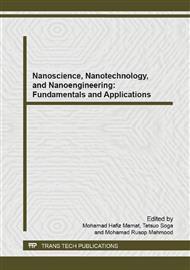[1]
P. Miró, M. Audiffred, T. Heine. An atlas of two-dimensional materials. Chemical Society Reviews. 43 (2014) 6537-6554.
DOI: 10.1039/c4cs00102h
Google Scholar
[2]
Z.A. Piazza, H. -S. Hu, W. -L. Li et al. Planar hexagonal B36 as a potential basis for extended single-atom layer boron sheets. Nature Communications 5 (2014) Art. ID 3113.
DOI: 10.1038/ncomms4113
Google Scholar
[3]
A. Kara, H. Enriquez, A.P. Seitsonen et al. A review on silicene - new candidate for electronics. Surface Science Reports 67 (2012) 1–18.
DOI: 10.1016/j.surfrep.2011.10.001
Google Scholar
[4]
L. Li et al. Buckled germanene formation on Pt (111). Advanced Materials 26 (2014) 4820–4824.
Google Scholar
[5]
Y. Xu, B. Yan, H.J. Zhang et al. Large-gap quantum spin hall insulators in tin films. Physical Review Letters 111 (2013) Art. ID 136804.
DOI: 10.1103/physrevlett.111.136804
Google Scholar
[6]
H. Liu et al. Phosphorene: an unexplored 2D semiconductor with a high hole mobility. ACS Nano 8 (2014) 4033–4041.
DOI: 10.1021/nn501226z
Google Scholar
[7]
P.C. Lin, S. Lin, P.C. Wang, R. Sridhar. Techniques for physicochemical characterization of nanomaterials. Biotechnology Advances 32 (2014) 711-726.
DOI: 10.1016/j.biotechadv.2013.11.006
Google Scholar
[8]
C.V. Raman. A new radiation. Indian Journal of Physics 2 (1928) 387-398.
Google Scholar
[9]
The Nobel Prize in Physics 1930,. Nobelprize. org. Nobel Media AB 2014. Web. 9 Sep 2014. http: /www. nobelprize. org/nobel_prizes/physics/laureates/1930/. Retrieved from the website by 9th September (2014).
Google Scholar
[10]
R. Singh. C.V. Raman and the discovery of the Raman effect. Physics in Perspective 4 (2002) 399-420.
Google Scholar
[11]
R.S. Das, Y.K. Agrawal. Raman spectroscopy: Recent advancement, techniques and applications. Vibrational Spectroscopy 57 (2011) 163-176.
DOI: 10.1016/j.vibspec.2011.08.003
Google Scholar
[12]
J. Burgdörfer, S. Rotter. Quantum Mechanics. Encyclopedia of Applied Physics. DOI: 10. 1002/3527600434. eap367. pub2.
Google Scholar
[13]
A. Einstein. Über einen die erzeugung und verwandlung des lichtes betreffenden heuristischen gesichtspunkt. Annalen der Physik 322 (1905) 132-148.
DOI: 10.1002/andp.19053220607
Google Scholar
[14]
L.M. Malard, M.A. Pimenta, G. Dresselhaus et al. Raman spectroscopy in graphene. Physics Reports 473 (2009) 51-87.
DOI: 10.1016/j.physrep.2009.02.003
Google Scholar
[15]
G. Dovbeshko, O. Fesenko, A. Dementjev et al. Coherent anti-Stoke Raman scattering enhancement of thymine adsorbed on graphene oxide. Nanoscale Research letters 9 (2014) Art. ID 263.
DOI: 10.1186/1556-276x-9-263
Google Scholar
[16]
R.P. Vidano, D.B. Fischbach. Observation of Raman band shifting with excitation wavelength for carbon and graphites. Solid State Communications 39 (1981) 341-344.
DOI: 10.1016/0038-1098(81)90686-4
Google Scholar
[17]
M. J. Matthews, M. A. Pimenta, G. Dresselhaus et al. Origin of dispersive effects of the Raman D band in carbon materials. Physical Review B 59 (1999) R6585.
DOI: 10.1103/physrevb.59.r6585
Google Scholar
[18]
M.S. Shamsudin, M. Mohammad, S.A.M. Zobir et al. Synthesis and nucleation-growth mechanism of almost catalyst-free carbon nanotubes grown from Fe-filled sphere-like graphene-shell surface. Journal of Nanostructure in Chemistry 3 (2013).
DOI: 10.1186/2193-8865-3-13
Google Scholar
[19]
L. Stobinski, B. Lesiak, A. Malolepszy et al. Graphene oxide and reduced graphene oxide studied by the XRD, TEM and electron spectroscopy methods. Journal of Electron Spectroscopy and Related Phenomena 195 (2014) 145-154.
DOI: 10.1016/j.elspec.2014.07.003
Google Scholar
[20]
F. Tuinstra, J.L. Koenig. Characterization of graphite fiber surfaces with Raman spectroscopy. Journal of Composite Materials 4 (1970) 492-499.
DOI: 10.1177/002199837000400405
Google Scholar
[21]
D.S. Knight, W.B. White. Characterization of diamond films by Raman spectroscopy. Journal of Materials Research 4 (1989) 385-393.
Google Scholar
[22]
L. Cançado. K. Takai. T. Enoki et al. General equation for the determination of the crystallite size La of nanographite by Raman spectroscopy. Applied Physics Letters 88 (2006) Art. ID 163106.
DOI: 10.1063/1.2196057
Google Scholar
[23]
M.A. Pimenta, G. Dresselhaus, M.S. Dresselhaus et al. Studying disorder in graphite-based systems by Raman spectroscopy. Physical Chemistry Chemical Physics 9 (2007) 1271-1291.
Google Scholar
[24]
M.S. Shamsudin, S.J. Fishlock, R. Ahmad et al. Fundamentals of two-dimensional crystallographic carbon form and its future directions: A review. Advanced Materials Research 832 (2014) 292-297.
DOI: 10.4028/www.scientific.net/amr.832.292
Google Scholar


